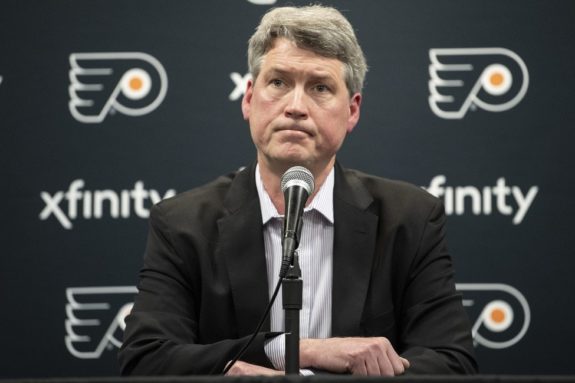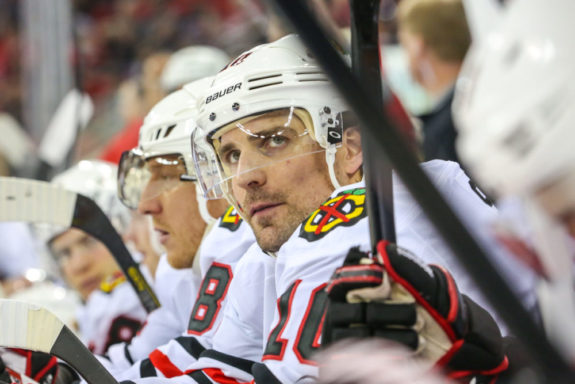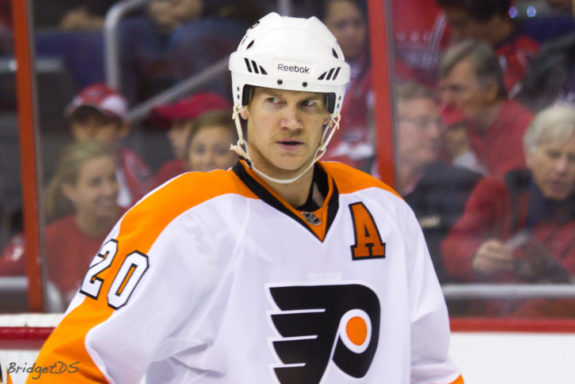
In both words and actions, Philadelphia Flyers general manager Chuck Fletcher has already shown that he’s going to use the team’s financial resources and collection of existing players and prospects to immediately return the franchise to relevance and contention.
He’s already splurged on the league’s most-experienced (and likely most-expensive) coaching staff. He’s already traded a low pick for negotiating rights to one of the league’s better-than-average free agents, center Kevin Hayes. And there’s plenty more to come.
“I think we’re going to be very aggressive in the trade and free agent markets in the sense of looking into every possible situation that can help us,” he said in a recent interview with NHL.com. “We’ve got the assets and the [NHL salary] cap space, and sometime in the near future, we’ll make some good things happen, and hopefully sooner rather than later.”

It’s hard for Flyers fans not to think of another recent Flyers GM when they hear comments like that. Paul Holmgren, who manned the phones from 2006 until 2014, was the embodiment of an aggressive, active (or overactive) GM, and the prospect of Fletcher bringing that same audacity delights some and terrifies others.
But the team that Fletcher recently took over looks nothing like the one Holmgren inherited in early 2006, and while changes are sure to come, the current GM is far better-equipped to make them than Holmgren ever was.
The Real Problem With the Holmgren Era
The 2006-07 Flyers that Holmgren inherited were bloated, badly built, and deeply flawed, with just a handful of sterling roster players (Simon Gagne, Jeff Carter, Mike Richards, injury-plagued Peter Forsberg), poor depth, no blue-chip prospects to speak of, and a mountain of dead weight. Ironically, the same can be said for the team he left behind seven years later.
But in between, the team played 13 playoff series, including two Eastern Conference Finals and one Stanley Cup Final, and enjoyed some of its best seasons since the late 1990s. His tenure began with a bang, when he turned over more than half the roster to vault a last-place team into a contender. Not long after, he’d make massive changes once again, beginning with the Richards/Carter blockbusters in 2011.
Holmgren saw needs and wanted to address them instantly–but there was a huge problem. He was always paying credit, not cash. His own predecessor, team legend Bob Clarke, left him little choice, having spent the last decade-plus shipping off countless draft picks and great youngsters like Justin Williams and Patrick Sharp for rentals or nothing at all.

Or, perhaps, Clarke did leave Holmgren with a choice – dwell at the bottom of the standings and horde draft picks to build a team for the future, or swing for the fences right then and there. And ever since the Flyers sent the Quebec Nordiques a ranch, a yacht, and a suitcase full of cash in exchange for Eric Lindros, that first approach was not really in the franchise’s DNA.
The Flyers don’t get to the 2008 Eastern Conference Final without swapping out a first round pick to sign Kimmo Timonen and Scott Hartnell, and then backing up a Brinks truck for Danny Briere. They don’t get within two wins of the 2010 Stanley Cup without acquiring Chris Pronger during the 2009 draft.
But Holmgren’s thin cupboard meant he was running up big talent debts. Pronger cost them their most-recent first round pick (Luca Sbisa, who held more value at the time than in retrospect) and their next two first rounders. Between 2009 and 2011, the Flyers were one of the best teams in the NHL. They also made no picks in the second round and just one in the first.

Injuries and bad, desperate signings depleted the roster and the wheels came off. The Flyers didn’t have the cheap, developing depth and eventual stars you’re supposed to generate in the draft. Instead, they were trading even more picks for the ability to sign Andrew MacDonald to a $30 million contract and throwing millions at a washed-up Vinny Lecavalier. Holmgren relinquished his role in 2014 and left Ron Hextall with a salary cap mess to clean up and no real farm system to offer relief.
Why the Fletcher Era Will Be Different
Like Holmgren, Fletcher seems poised to go find established players to fill the holes in the roster. But unlike Holmgren, he has cash to do it–both literally and figuratively. Hextall spent the last four seasons padding the team’s coffers with a robust array of prospects and cost-controlled under-23 NHL talents, not to mention a yawning window beneath the salary cap ceiling.
The team now boasts one of the league’s youngest defenses, stocked with three extremely young, high-potential players in Travis Sanheim, Ivan Provorov, and Philippe Myers. The veteran forward group of Couturier, Claude Giroux, and Jakub Voracek is backed by a strong bunch in Oskar Lindblom, Travis Konecny, and Nolan Patrick, and behind that there’s a glut of dangerous upcoming talents like Morgan Frost, Joel Farabee, and Isaac Ratcliffe. And little needs to be said of the young goaltender, Carter Hart.

But it’s a fanbase that expects excellence and has seen nothing close to that in recent years. It’s a franchise that’s watching one of its best-ever players creep past 30, having not sniffed the second round of the playoffs since he was 24. And it’s a league quivering with talk of offer sheets, a looming expansion draft, and one of its most exciting free agent classes in recent memory.
During the last few years of on-ice mediocrity, fans have grown attached to some of the alluring prospects, and to unique players like Shayne Gostisbehere (whose name is bubbling up in rampant trade speculation). Many will shudder at the idea of any of them being moved, but it may be high time for Fletcher to channel some of Holmgren’s gall.
Embracing the Audacity
There’s certainly reason for apprehension when trading away prospects who could be the next superstar, moving on from young roster players on great value contracts, or strapping up and heading into the Wild West that is NHL unrestricted free agency. Perceived overpayment will always be inevitable. But on the ice, a somewhat excessive contract doesn’t matter, if it’s not keeping you from signing the rest of your team. And missing a first or second round pick isn’t going to cripple one of the league’s best prospect pools.
The payoff could be enormous. For all of his late-tenure missteps and poor planning, Holmgren brought the team closer to a Stanley Cup than it had been since 1987. Closer than the magical (and equally trade-happy) 2004 team ever got. Closer than the dominant Legion of Doom era squads ever got.
Impatience and high expectations have sometimes hamstrung the organization, but under Holmgren, they brought the Flyers within a couple of bounces of their first championship since 1975. To stunt the future the way Holmgren did, Fletcher would have to work almost twice as hard and make three times as many mistakes. With all the resources at his disposal, and the league in its current state, perhaps the fear shouldn’t be that Fletcher embraces that same audacity: It should be that he doesn’t.